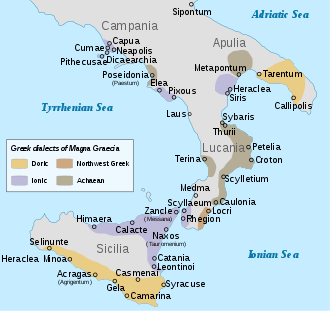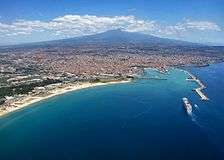Southern Italy
Southern Italy (Italian: Sud Italia; Neapolitan: 'o Sudde; Sicilian: Italia dû Sud) or Mezzogiorno (Italian pronunciation: [ˌmɛddzoˈdʒorno],[2] literally "Midday" or "Noon";[3][4] in Neapolitan: 'o Miezujuorno; in Sicilian: Mezzujornu) is a macroregion of Italy meant to broadly denote the southern half of the Italian state.
Southern Italy Mezzogiorno | |
|---|---|
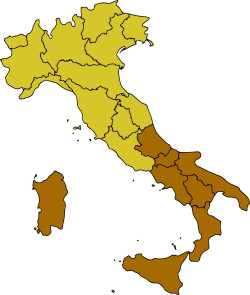 | |
| Country | Italy |
| Regions | |
| Area | |
| • Total | 123,024 km2 (47,500 sq mi) |
| Population | |
| • Estimate (2019) | 20,637,360 |
| Languages | |
| – Official language | Italian |
| – Historical linguistic minorities | |
| – Regional languages | |
Southern Italy covers in both historic and cultural terms the land once under the administration of the former Kingdoms of Naples and Sicily (officially denominated Regnum Siciliae citra Pharum and ultra Pharum, that is "Kingdom of Sicily on the other side of the Strait" and "across the Strait"), which shared a common organization into Italy's largest pre-unitarian state, the Kingdom of the two Sicilies.[5][6][7][8][9] The island of Sardinia had a different history from the aforementioned regions, but is nonetheless often grouped together with the Mezzogiorno.[10][11]
The Italian National Institute of Statistics (ISTAT) employs the term "South Italy" (Italia Meridionale) to identify one of the five statistical regions in its reportings without Sicily and Sardinia, which form a distinct statistical region denominated "Insular Italy" (Italia Insulare).[12] These same subdivisions are at the bottom of the Italian First level NUTS of the European Union and the Italian constituencies for the European Parliament.
Etymology
In a similar fashion to France's Midi ("midday" or "noon" in French), the Italian term Mezzogiorno refers to the intensity and the position of sunshine at midday in the South of the Italian peninsula.[3] The term later came into vogue after the annexation of the Bourbon Kingdom of the Two Sicilies, together with the other Italian states, and the subsequent Italian unification of 1861.
Regions
Southern Italy is generally thought to comprise the administrative regions that correspond to the geopolitical extent of the historical Kingdom of the Two Sicilies, starting from Abruzzo, Apulia, Basilicata, Campania, Calabria, Molise, and Sicily; because of this historical reason, and the fact that southern Italian dialects are spoken there as well, some also include the southernmost and easternmost parts of Lazio, (namely the districts of Frosinone, Sora, Cassino, Gaeta, Cittaducale, Formia and Amatrice) within the Mezzogiorno. The island of Sardinia, although being culturally, linguistically and historically less related to the aforementioned regions than any of them is to each other, is frequently included as part of the Mezzogiorno,[11][13] often for statistical and economical purposes.[14][13][15]
Geography
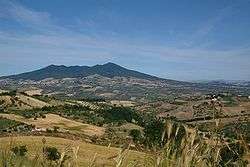
Southern Italy forms the lower part of the Italian "boot", containing the ankle (Campania), the toe (Calabria), the arch (Basilicata), and the heel (Apulia), Molise (north of Apulia) and Abruzzo (north of Molise) along with Sicily, removed from Calabria by the narrow Strait of Messina. Separating the "heel" and the "boot" is the Gulf of Taranto, named after the city of Taranto, which is at an angle between the heel and the boot itself. It is an arm of the Ionian Sea.
The island of Sardinia, to the west of the Italian peninsula and right below the French island of Corsica, might also be included.
On the eastern coast is the Adriatic Sea, leading into the rest of the Mediterranean through the Strait of Otranto (named after the largest city on the tip of the heel). On the Adriatic, south of the "spur" of the boot, the peninsula of Monte Gargano; on the Tyrrhenian Sea, the Gulf of Salerno, the Gulf of Naples, the Gulf of Policastro and the Gulf of Gaeta are each named after a large coastal city. Along the northern coast of the Salernitan Gulf and on the south of the Sorrentine Peninsula runs the Amalfi Coast. Off the tip of the peninsula is the isle of Capri.
The climate is mainly Mediterranean (Köppen climate classification Csa), except at the highest elevations (Dsa, Dsb) and the semi-arid eastern stretches in Apulia and Molise, along the Ionian Sea in Calabria and the southern stretches of Sicily (BSw). The largest city of Southern Italy is Naples, a name from the Greek that it has historically maintained for millennia. Bari, Taranto, Reggio Calabria, Foggia, and Salerno are the next largest cities in the area. The region is geologically very active, with the exception of Salento in Apulia, and highly seismic: the 1980 Irpinia earthquake killed 2,914 people, injured more than 10,000 and left 300,000 homeless.
History
Prehistory and antiquity
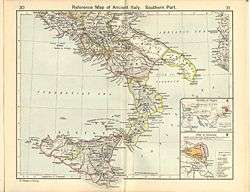
.
In the 8th and 7th centuries BCE, for various reasons, including demographic crisis (famine, overcrowding, etc.), the search for new commercial outlets and ports, and expulsion from their homeland, Greeks began to settle in Southern Italy.[17] Also during this period, Greek colonies were established in places as widely separated as the eastern coast of the Black Sea, Eastern Libya and Massalia (Marseille). They included settlements in Sicily and the southern part of the Italian Peninsula. The first Greek settlers found Italy inhabited by three major populations: Ausones, Oenotrians and Iapyges (these last ones were subdivided into three tribes: Daunians, Peucetians and Messapians). The relationships between the Greek settlers and the native peoples were initially hostile (especially with the Iapygian tribes), but finally the hellenic influence definitely shaped their culture and way of life.
The Romans used to call the area of Sicily and coastal Southern Italy Magna Graecia ("Great Greece"), since it was so densely inhabited by the Greeks; the ancient geographers differed on whether the term included Sicily or merely Apulia and Calabria—Strabo being the most prominent advocate of the wider definitions.
With this colonisation, Greek culture was exported to Italy, in its dialects of the Ancient Greek language, its religious rites and its traditions of the independent polis. An original Hellenic civilization soon developed, later interacting with the native Italic and Latin civilisations. The most important cultural transplant was the Chalcidean/Cumaean variety of the Greek alphabet, which was adopted by the Etruscans; the Old Italic alphabet subsequently evolved into the Latin alphabet, which became the most widely used alphabet in the world.
Many of the new Hellenic cities became very rich and powerful, like Neapolis (Νεάπολις, Naples, "New City"), Syrakousai (Συράκουσαι, Syracuse), Akragas (Ἀκράγας, Agrigento), and Sybaris (Σύβαρις, Sibari). Other cities in Magna Graecia included Tarentum (Τάρας), Epizephyrian Locri (Λοκροὶ Ἐπιζεφύριοι), Rhegium (Ῥήγιον), Croton (Κρότων), Thurii (Θούριοι), Elea (Ἐλέα), Nola (Νῶλα), Syessa (Σύεσσα), Bari (Βάριον), and others.
After Pyrrhus of Epirus failed in his attempt to stop the spread of Roman hegemony in 282 BCE, the south fell under Roman domination and remained in such a position throughout the barbarian invasions (the Gladiator War is a notable suspension of imperial control). It was restored to Eastern Roman control in the 530s after the fall of Rome in the West in 476, and some form of imperial authority survived until the 1070s. Total East Roman rule was ended by the Lombards by Zotto's conquest in the final quarter of the 6th century.
Middle Ages
Following the Gothic War (535–554), and until the arrival of the Normans, much of Southern Italy's destiny was linked to the fortunes of the Eastern Empire, even though Byzantine domination was challenged in the 9th century by the Lombards, who annexed the area of Cosenza to their Duchy of Benevento. Consequently, the Lombard and the Byzantine areas became influenced by Eastern monasticism and much of Southern Italy experienced a slow process of orientalisation in religious life (rites, cults and liturgy), which accompanied a spread of Eastern churches and monasteries that preserved and transmitted the Greek and Hellenistic tradition (the Cattolica monastery in Stilo is the most representative of these Byzantine monuments). From then to the Norman conquest of the 11th century, the south of the peninsula was constantly plunged into wars between the Byzantines, Lombardy, and the Islamic Caliphate. The latter established several Islamic states in southern Italy, such as the Emirate of Sicily and Emirate of Bari. Amalfi, an independent republic from the 7th century until 1075, and to a lesser extent Gaeta, Molfetta and Trani, rivalled other Italian maritime republics in their domestic prosperity and maritime importance.
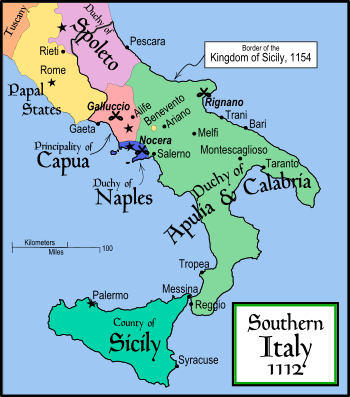
In the 11th century, the Normans occupied all the Lombard and Byzantine possessions in Southern Italy, ending a millenium of imperial Roman rule in Italy, and eventually expelled the Muslims from Sicily. The Norman Kingdom of Sicily under Roger II was characterised by its competent governance, multi-ethnic nature and religious tolerance. Normans, Jews, Muslim Arabs, Byzantine Greeks, Lombards and "native" Sicilians lived in relative harmony.[18] However, the Norman domination lasted only several decades before it formally ended in 1198 with the reign of Constance of Sicily, and was replaced by that of the Swabian Hohenstaufen dynasty.

In Sicily, Emperor Frederick II endorsed a deep reform of the laws culminating with the promulgation of the Constitutions of Melfi (1231, also known as Liber Augustalis), a collection of laws for his realm that was remarkable for its time and was a source of inspiration for a long time after.[19] It made the Kingdom of Sicily a centralised state and established the primacy of written law. With relatively small modifications, the Liber Augustalis remained the basis of Sicilian law until 1819. His royal court in Palermo, from around 1220 to his death, saw the first use of a literary form of an Italo-Romance language, Sicilian, that had a significant influence on what was to become the modern Italian language. During this period, he also built the Castel del Monte, and in 1224, he founded the University of Naples, now called, after him, Università Federico II.[20]
In 1266, conflict between the Hohenstaufen house and the Papacy led to Sicily's conquest by Charles I, Duke of Anjou. Opposition to French officialdom and taxation combined with incitement of rebellion by agents from the Byzantine Empire and the Crown of Aragon led to the Sicilian Vespers insurrection and successful invasion by king Peter III of Aragon in 1282. The resulting War of the Sicilian Vespers lasted until the Peace of Caltabellotta in 1302, dividing the old Kingdom of Sicily in two. The island of Sicily, called the "Kingdom of Sicily beyond the Lighthouse" or the Kingdom of Trinacria, went to Frederick III of the house of Aragon, who had been ruling it. The peninsular territories, contemporaneously called Kingdom of Sicily, but called Kingdom of Naples by modern scholarship, went to Charles II of the House of Anjou, who had likewise been ruling it. Thus, the peace was formal recognition of an uneasy status quo.[21] Despite the king of Spain being able to seize both the two crowns starting from the 16th century, the administrations of the two halves of the Kingdom of Sicily remained separated until 1816, when they were reunited in the Kingdom of Two Sicilies.

Early modern history
In 1442, however, Alfonso V conquered the Kingdom of Naples and unified Sicily and Naples once again as dependencies of the Crown of Aragon. At his death in 1458, the kingdom was again separated and Naples was inherited by Ferrante, Alfonso's illegitimate son. When Ferrante died in 1494, Charles VIII of France invaded Italy, using the Angevin claim to the throne of Naples, which his father had inherited on the death of King René's nephew in 1481, as a pretext, thus beginning the Italian Wars. Charles VIII expelled Alfonso II of Naples from Naples in 1495, but was soon forced to withdraw due to the support of Ferdinand II of Aragon for his cousin, Alfonso II's son Ferrantino. Ferrantino was restored to the throne, but died in 1496, and was succeeded by his uncle, Frederick IV. The French, however, did not give up their claim, and in 1501 agreed to a partition of the kingdom with Ferdinand of Aragon, who abandoned his cousin King Frederick. The deal soon fell through, however, and the Crown of Aragon and France resumed their war over the kingdom, ultimately resulting in an Aragonese victory leaving Ferdinand in control of the kingdom by 1504.
The kingdom continued to be a focus of dispute between France and Spain for the next several decades, but French efforts to gain control of it became feebler as the decades went on, and Spanish control was never genuinely endangered. The French finally abandoned their claims to the kingdom by the Treaty of Cateau-Cambrésis in 1559. With the Treaty of London (1557) the new client state of "Stato dei Presidi" (State of Presidi) was established and governed directly by Spain, as part of the Kingdom of Naples.
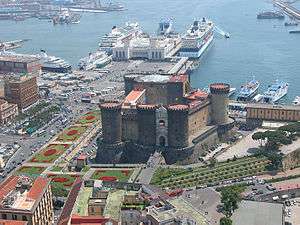
The administration of the Kingdom of Naples and Sicily, as well as the Duchy of Milan, was run by the Council of Italy. The island of Sardinia, that came to be under full Iberian sovereignty in 1409 at the fall of the last indigenous state, had been an integral part of the Council of Aragon instead and kept being as such until the first years of the XVIII° century, when Sardinia was ceded to Austria and eventually Savoy.
After the War of the Spanish Succession in the early 18th century, possession of the kingdom again changed hands. Under the terms of the Treaty of Utrecht in 1713, Naples was given to Charles VI, the Holy Roman Emperor. He also gained control of Sicily in 1720, but Austrian rule did not last long. Both Naples and Sicily were conquered by a Spanish army during the War of the Polish Succession in 1734, and Charles, Duke of Parma, a younger son of King Philip V of Spain was installed as King of Naples and Sicily from 1735. When Charles inherited the Spanish throne from his older half-brother in 1759, he left Naples and Sicily to his younger son, Ferdinand IV. Despite the two kingdoms being in a personal union under the House of Bourbon from 1735 onwards, they remained constitutionally separated.
Early 19th century

Being a member of the House of Bourbon, King Ferdinand IV was a natural opponent of the French Revolution and Napoleon. In January 1799, Napoleon Bonaparte, in the name of the French Republic, captured Naples and proclaimed the Parthenopaean Republic, a French client state, as successor to the kingdom. King Ferdinand fled from Naples to Sicily until June of that year. In 1806, Bonaparte, by then French Emperor, again dethroned King Ferdinand and appointed his brother, Joseph Bonaparte, as King of Naples. In the Edict of Bayonne of 1808, Napoleon removed Joseph to Spain and appointed his brother-in-law, Joachim Murat, as King of the Two Sicilies, though this meant control only of the mainland portion of the kingdom.[22][23] Throughout this Napoleonic interruption, King Ferdinand remained in Sicily, with Palermo as his capital.
After Napoleon's defeat, King Ferdinand IV was restored by the Congress of Vienna of 1815 as Ferdinand I of the Two Sicilies. He established a concordat with the Papal States, which previously had a claim to the land.[24] There were several rebellions on the island of Sicily against the King Ferdinand II but the end of the kingdom was only brought about by the Expedition of the Thousand in 1860, led by Garibaldi, an icon of the Italian unification, with the support of the House of Savoy and their Kingdom of Sardinia. The expedition resulted in a striking series of defeats for the Sicilian armies against the growing troops of Garibaldi. After the capture of Palermo and Sicily, he disembarked in Calabria and moved towards Naples, while in the meantime the Piedmontese also invaded the Kingdom from the Marche. The last battles fought were that of the Volturnus in 1860 and the siege of Gaeta, where King Francis II had sought shelter, hoping for French help, which never came. The last towns to resist Garibaldi's expedition were Messina (which capitulated on 13 March 1861) and Civitella del Tronto (which capitulated on 20 March 1861). The Kingdom of the Two Sicilies was dissolved and annexed to the new Kingdom of Italy, founded in the same year.
Southern and Northern Italy in 1860
At the time of the Italian unification, the gap between the former Northern states of Italy and the Southern two Sicilies was significant: Northern Italy was home to roads for about 75,500 kilometers and railroads for 2,316 kilometers, combined with a wide range of channels connected to rivers for goods transportation; iron and steel production was 17,000 tons per year. On the contrary, in the former Bourbon Southern state, there were 14,700 kilometers of roads, 184 kilometers of railroads only near Naples, no channels connected to rivers and iron and steel production was 1,500 tons per year.
_-_Geographicus_-_ItalySouth-mitchell-1850.jpg)
In 1860, illiteracy rates on the Italian peninsula of 1860 had an average of 75%, with the lowest peak of 54% being in the northwestern Kingdom of Sardinia (also known as "Piedmont"), and the highest to the south, where illiteracy in the Kingdom of the Two Sicilies reached 87%.[25]
In 1860 the southern merchant navy amounted to 260,000 tons, whereas the northern merchant navy 347,000 tons, aside from the Venetian navy annexed in 1866 and assessed 46,000 tons. In 1860 the whole Italian merchant navy was the fourth of Europe with about 607,000 tons.[26] The Southern merchant navy was made up of sailing vessels mainly for fishing and coastal shipping in the Mediterranean Sea and it had very few steamships, even if one of the first steamers was built and fitted in Naples in 1818. Both merchant and military navy were insufficient compared to the great coastal extent of Southern Italy defined by the Italian historian Raffaele De Cesare: "… a great pier towards South".[27]
In addition to the merchant navy we must also consider the waterway network connected with rivers and canals, which was used to transport goods in a large area, the waterway network was highly developed in the north and nonexistent in the south.
In the article This is Not Italy! Ruling and Representing the South, it is clear how the Northern elites considered the South. The Piedmontese North felt the need to invade the Kingdom of the two Sicilies and establish a new form of governance based on the Northern system since they viewed the South as under-developed and lacking of social capital. These views of the South can largely be attributed to the letters of correspondents in southern Italy who sent biased letters to leaders of the North, specifically Camillo Benso, urging for the invasion and reformation of the South. Although these views of the South were condescending, they also came with a genuine belief that in order to create a unified Italy, help from the North was necessary. Viewing southern Italy as barbaric, served as a sort of justification to allow the "civilized, Piedmontese north" (167) to intervene. Another view however was marked with disdain of Southern Italy. According to the article, "such manifestations of the south's difference threaten the glowing and gloating sense of northern superiority" (167). These viewpoints clearly indicate the divide between Northern and Southern Italy in the 1860s.[28]
Denis Mack Smith, British historian, describes the radical difference between the Northern and the newly annexed Southern Italy in 1860, for these two halves were on quite different levels of civilization, pointing out that the Bourbon in the Kingdom of the Two Sicilies were staunch supporters of a feudal system and that they had feared the traffic of ideas and had tried to keep their subjects insulated from the agricultural and industrial revolutions of northern Europe.[29]
The above-mentioned study by Denis Mack Smith is confirmed by the Italian historian and left wing politician Antonio Gramsci in his book "The Southern Question", by which the author emphasizes the "absolutely antithetical conditions" of Northern and Southern Italy at the time of the Italian Unification in 1861, when South and North united themselves again after more than one thousand years.
Gramsci remarks that, in the North of Italy, the historical period of the Comunes had given special boost to history and in Northern Italy existed an economic organization similar to that of the other states of Europe, propitious to further development of capitalism and industry, whereas in Southern Italy history had been different and the fatherly Bourbon administrations produced nothing of value; the bourgeois class did not exist, agriculture was primitive and insufficient to satisfy the local market, there were no roads, no ports, the few waters that the region had were not exploited, due to its special geographical feature.[30]
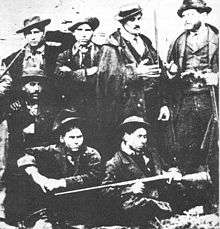
Life conditions of the people of the Kingdom of the Two Sicilies are illustrated also by Raffaele De Cesare,[31] who reports the lack of interest from the king of Naples Ferdinand II to do useful works to change the neglected conditions of public hygiene, particularly in the provinces where scarcity of sewer systems and often water shortage were known issues. [32]
The problem of brigandage is explained in the book Heroes and Brigands by the southern Italian historian and politician Francesco Saverio Nitti, outlining that brigandage was endemic in Southern Italy, since the Bourbons themselves relied on it as their military agent.[33] Unlike Southern Italy, there was little brigandage in the other annexed states of northern and central Italy, like the Kingdom of Lombardy-Venetia, the Duchy of Parma, the Duchy of Modena, the Grand Duchy of Tuscany and the Papal States, because the situation of Southern Italy was different, owing to the previous centuries of history.
According to the southern Italian historian Giustino Fortunato,[34] and Italian institutional sources[35] the problems of Southern Italy existed way before the Italian Unification, in this regard Giustino Fortunato underlines that the Bourbon were not the only ones responsible for southern problems, that had ancient and deep origins also in previous centuries of poverty and isolation, caused by foreign dominations and governments.
In literature the period of 1860 is described by the Sicilian writer Giuseppe Tomasi di Lampedusa in his famous novel The Leopard (Il Gattopardo) set in Sicily during the years of the Italian unification, in a famous final scene prince Salina, when invited to join the senate of unified Italy, answers to an important Piedmontese officer " …the Sicilian will never want to change, because the Sicilian feels perfect …", by which and by other words the author underlines the problem for the Sicilians to change their old life style while remaining in their island. The novel was represented in the homonymous film The Leopard (1963 film) by Luchino Visconti in which the actor Burt Lancaster played as Prince Salina.
After 1861
The southern economy greatly suffered after the Italian unification and the process of industrialisation was interrupted. Poverty and organised crime were long-standing issues in Southern Italy as well and it got worse after unification. Cavour stated the basic problem was poor government, and believed the solution lied in the strict application of the Piedmonese legal system. The main result was an upsurge in brigandage.[36] Because of this, the South experienced great economic difficulties resulting in massive emigration leading to a worldwide Italian diaspora, especially to North America, South America, Australia, and other parts of Europe. Many natives also relocated to the industrial cities in northern Italy, such as Genoa, Milan and Turin. A relative process of industrialisation has developed in some areas of the "Mezzogiorno" after World War II. In the 1946 referendum after the war, the region voted to keep the monarchy, with its greatest support coming in Campania. Politically, it was at odds with northern Italy, which won the referendum to establish a republic.[37] Today, the South remains less economically developed than the northern and central regions, which enjoyed an "economic miracle" in the 1950s and 1960s and became highly industrialized.
Demography
Population
|
Rank | City | Region | Population |
|
|---|---|---|---|---|---|
| 1 | Naples | Campania | 955,503 | ||
| 2 | Palermo | Sicily | 659,894 | ||
| 3 | Bari | Apulia | 319,482 | ||
| 4 | Catania | Sicily | 311,777 | ||
| 5 | Messina | Sicily | 231,708 | ||
| 6 | Taranto | Apulia | 195,279 | ||
| 7 | Reggio Calabria | Calabria | 179,049 | ||
| 8 | Cagliari | Sardinia | 154,108 | ||
| 9 | Foggia | Apulia | 150,185 | ||
| 10 | Salerno | Campania | 132,640 | ||
| Sources: 2019 Demo Istat[38] | |||||
Economy
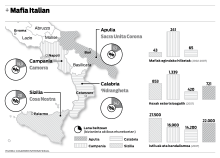
Starting from the unification of Italy in 1861–1870, a growing economic divide between the northern provinces and the southern half of Italy became evident.[39] In the early decades of the new kingdom, the lack of effective land reform, heavy taxes, and other economic measures imposed on the South, along with the removal of protectionist tariffs on agricultural goods imposed to boost northern industry, made the situation nearly impossible for many tenant farmers, small businesses and land owners. Multitudes chose to emigrate rather than try to eke out a meagre living, especially from 1892 to 1921.[40] In addition, the surge of brigandage and mafia provoked widespread violence, corruption and illegality. Prime Minister Giovanni Giolitti once conceded that places existed "where the law does not operate at all".[41]
After the rise of Benito Mussolini, the "Iron Prefect", Cesare Mori tried to defeat the already powerful criminal organizations flowering in the South, with some degree of success. However, when connections between mafia and the Fascists emerged, Mori was removed and the Fascist propaganda declared the mafia defeated.[42] Economically, Fascist policy aimed at the creation of an Italian Empire and Southern Italian ports were strategic for all commerce towards the colonies. Naples enjoyed a demographic and economic rebirth, mainly due to the interest of King Victor Emmanuel III, who was born there.[43]
Starting from the 1950s, the Cassa per il Mezzogiorno was set up as a huge public master plan to help industrialise the South, that aimed to do this in two ways: by land reforms creating 120,000 new small farms, and through the "Growth Pole Strategy" whereby 60% of all government investment would go to the South, thus boosting the Southern economy by attracting new capital, stimulating local firms, and providing employment. However, the objectives were largely missed, and as a result the South became increasingly subsidised and state-dependent, incapable of generating private growth itself.[44] Presently, huge regional disparities still persist. Problems still include pervasive organised crime and very high unemployment rates.
Due to Southern Italy's lack of progress in bettering the area, it has had record numbers of emigration. The most prevalent issue in Southern Italy is its inability to attract businesses, and therefore create jobs. Between 2007 and 2014, 943,000 Italians were unemployed. From this figure, 70% were Italians from the South.[45] Employment in the South is ranked the lowest when compared to countries in the European Union.[45] Italians from the South are also ranked the lowest in terms of financial contributions into the economy of the Italy from immigrants.[46] The most common jobs in Southern Italy lie in tourism, distribution, food industries, wood furniture, whole sale, vehicle sales, sales in mineral and artisan fields.[47] As is evident in the list of the most common jobs in Southern Italy, the economy of the South heavily relies on tourism. It attracts tourists through its rich historical background.
A report published in July 2015 by the Italian organization SVIMEZ shows that Southern Italy has had a negative GDP growth in the last seven years, and that from the year 2000 it has been growing half as much as Greece.[48]
In 2016, Southern Italy's GDP and economy was growing twice as much as Northern Italy's.[49] According to Eurostat figures published in 2019, Southern Italy is the European area with the lowest employment percentages: in Apulia, Sicily, Campania and Calabria, less than 50% of the people aged between 20 and 64 had a job in 2018. This is largely due to the low participation of women in the workforce, as less than 50% of the women are employed, compared to a national and European average of 53.1% and 67.4%, respectively.[50][51]
Culture
The regions of Southern Italy were exposed to some different historical influences than the rest of the peninsula, starting most notably with Greek colonisation. Greek influence in the South was dominant until Latinisation was completed by the time of the Roman Principate. Greek influences returned by the late Roman Empire, especially following the reconquests of Justinian and the Byzantine Empire.

Sicily, a distinctive Norman-Arab-Byzantine culture throughout the Middle Ages, was captured by Muslims and turned into an Emirate for a period, and via Sicily, elements of Arab culture were introduced to Italy and Europe. The rest of the mainland was subject to a struggle of power among the Byzantines, Lombards, and Franks. In addition, the Venetians established outposts as trade with Byzantium and the Near East increased.
Until the Norman conquests of the 11th and 12th centuries much of the South followed Eastern rite (Greek) Christianity. The Normans who settled in Sicily and Southern Italy in the Middle Ages significantly impacted the architecture, religion and high culture of the region. Later, Southern Italy was subjected to rule by the new European nation states, first the Crown of Aragon, then Spain, and then Austria. The Spanish had a major impact on the culture of the South, having ruled it for over three centuries.
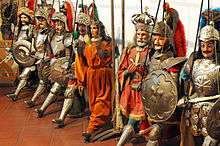
Jewish communities lived in Sicily and Southern Italy for over 15 centuries, but in 1492 King Ferdinand II of Aragon proclaimed the Edict of expulsion. At their height, Jewish Sicilians probably constituted around one tenth of the island's population. After the Edict, they partially converted to Christianity and some moved to Ottoman Empire and other places in Southern Italy, Rome and Europe. In the 19th century, street musicians from Basilicata began to roam worldwide to seek a fortune, most of them would become professional instrumentalists in symphonic orchestras, especially in the United States.[52]
Southern Italy has many major tourist attractions, such as the Palace of Caserta, the Amalfi Coast, Pompeii and other archaeological sites (many of which are protected by UNESCO). There are also many ancient Greek cities in Southern Italy, such as Sybaris and Paestum, which were founded several centuries before the start of the Roman Republic. Some of its beaches, woodlands and mountains are preserved in several National Parks; a major example is La Sila, a mountainous plateau occupying the provinces of Cosenza and Catanzaro in the region of Calabria.
In recent years, Southern Italy has experienced a revival of its traditions and music, such as the Neapolitan song and the Tarantella.
- Linguistic borders of the Italo-Dalmatian Southern Italian
 Range of the Southern Italian dialects (Neapolitan)
Range of the Southern Italian dialects (Neapolitan)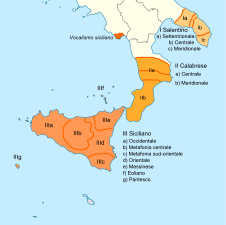 Range of the Extreme Southern Italian dialects (Sicilian)
Range of the Extreme Southern Italian dialects (Sicilian)
See also
- Meridionalism
- Southern Italy autonomist movements
- Italian NUTS level 1 regions
References
- "Statistiche demografiche ISTAT". www.demo.istat.it.
- "Dizionario d'ortografia e di pronunzia". www.dizionario.rai.it.
- "Mezzogiorno". Encyclopædia Britannica. Retrieved 23 July 2016.
- "meżżogiórno in Vocabolario - Treccani". www.treccani.it.
- «Con questa denominazione si indica lo Stato costituito nel dic. 1816 con l’unificazione dei regni di Napoli e di Sicilia, che restaurava l’autorità borbonica su tutta l’Italia meridionale; fu mantenuta fino all’ott. 1860, quando, tramite plebiscito, fu votata l’annessione al regno di Sardegna.» "Regno delle Due Sicilie in Dizionario di Storia". www.treccani.it.
- «Mezzogiorno, region in Italy roughly coextensive with the former Kingdom of Naples.» "Mezzogiorno". Encyclopædia Britannica. Retrieved 23 July 2016.
- «Meridionale: in part.: che fa parte delle regioni continentali e insulari del Mezzogiorno d'Italia (delimitate convenzionalmente dai fiumi Garigliano e Sangro), le quali, in età prerisorgimentale, costituivano il Regno delle due Sicilie.» Battaglia, Salvatore (1961). Grande dizionario della lingua italiana, UTET, Torino, V. X, p.160.
- «Il regno meridionale, Napoli e Sicilia con 6 milioni e 200 mila abitanti,... pare in principio per certa foga di riforme e per valori d'ingegni filosofici e riformisti gareggiare con la Lombardia austriaca.» Carducci, III-18-21, citato in Grande dizionario della lingua italiana, UTET, Torino, V. X, p.160.
- Luigi Mendola. "Kingdom and House of the Two Sicilies".
- "Il rapporto annuale Svimez sull'economia del Mezzogiorno". 2007.
- "Classificazione economica ISTAT" (PDF) (in Italian). Retrieved October 23, 2009.
- "Classificazione demografica ISTAT" (in Italian). Retrieved October 23, 2009.
- Apostolopoulos, Yorgos; Leontidou, Lila; Loukissas, Philippos (2014). Mediterranean Tourism: Facets of Socioeconomic Development and Cultural Change. Routledge. ISBN 9781317798385.
- Hospers, Gert J. (2004). Regional Economic Change in Europe. LIT Verlag Münster. ISBN 9783825881771.
- Jepson, Tim; Soriano, Tino (2011). National Geographic Traveler: Naples and Southern Italy (2nd ed.). National Geographic Books. ISBN 9781426207105. Retrieved 23 July 2016.
- Roger D. Woodard (2008). "Greek dialects", in: The Ancient Languages of Europe. Cambridge University Press. p. 51. ISBN 978-0-521-68495-8.
- Cerchiai, Lucia; Jannelli, Lorena; Longo, Fausto (2004). The Greek cities of Magna Graecia and Sicily. Los Angeles: Getty Trust Publications. pp. 14–18. ISBN 0-89236-751-2.
- "Sicilian Peoples: The Normans - Best of Sicily Magazine - Normans in Sicilian History". www.bestofsicily.com.
- Georgina Masson (1973). Frederick II of Hohenstaufen: a life. London: Octagon Books. p. 156. ISBN 0-374-95297-3.
- Hunt Janin (2008). The University in Medieval Life, 1179–1499. McFarland. p. 132. ISBN 978-0-7864-3462-6.
- Sir Steven Runciman (1958). The Sicilian Vespers: a history of the Mediterranean world in the later thirteenth century. Cambridge University Press. p. 274. ISBN 0-521-43774-1.
- Colletta, Pietro (1858). History of the Kingdom of Naples (1858). University of Michigan.
Edict of Bayonne.
- "The Battle of Tolentino, Joachim Murat". Tolentino815.it. 7 October 2007. Archived from the original on 1 February 2008.
- Blanch, L. Luigi de' Medici come uomo di stato e amministratore. Archivio Storico per le Province Napoletane.
- "The Italian Unification (L'Unificazione Italiana)- Treccani with contribution of Aspen Italy – Section IV – pages 417–418 illiteracy, p. 419 iron/steel, p. 420 roads and channels, p. 421 railroads )" (PDF).
- National unification and economic development in Italy 1750–1913 (Unità nazionale e sviluppo economico in Italia 1750–1913) by Guido Pescosolido pages 95,133 – Italian edition ISBN 9788868124229
- De Cesare, Raffaele (July 6, 1900). "La fine di un regno (Napoli e Sicilia)". Città di Castello, S. Lapi – via Internet Archive.
- "This Is Not Italy!" Ruling and Representing the South, 1860–1861
- Modern Italy: A Political History – Denis Mack Smith – University of Michigan Press (1998) – ISBN 0472108956 – page 3
- "Antonio Gramsci La Questione Meridionale". archive.org.
- Raffaele De Cesare (1845–1918), southern Italian historian and politician
- De Cesare, Raffaele (July 6, 1900). "La fine di un regno (Napoli e Sicilia)". Città di Castello, S. Lapi – via Internet Archive.
- Heroes and brigands (Eroi e briganti) by Francesco Saverio Nitti – (edition 1899) – Osanna Edizioni 2015 – ISBN 9788881674695 – page 33
- Fortunato, Giustino (July 6, 1911). "Il Mezzogiorno e lo stato italiano; discorsi politici (1880-1910)". Bari G. Laterza – via Internet Archive.
- "La Scuola per i 150 anni dell'Unità d'Italia - Il problema del Mezzogiorno - Il divario di partenza". www.150anni.it.
- Roland Sarti, Italy: A Reference Guide from the Renaissance to the Present (2004) pp 567–8
- Sexton, Renard (December 15, 2009). "Berlusconi the Survivor". FiveThirtyEight.com.
- "Statistiche demografiche ISTAT". demo.istat.it.
- Mignone, Mario B. (2008). Italy today: Facing the Challenges of the New Millennium. New York: Lang Publishing. p. 181. ISBN 978-1-4331-0187-8.
- Dennis Mack Smith (1997). Modern Italy; A Political History. Ann Arbor: The University of Michigan Press. ISBN 978-0-472-10895-4, pp. 209–210
- (Smith (1997), pp. 199.)
- Newark, Tim (2007). Mafia Allies: The True Story of America's Secret Alliance with the Mob in World War II. London: MBI Publishing Company. pp. 47–48. ISBN 978-0-7603-2457-8.
- "Victor Emmanuel III | king of Italy". Encyclopedia Britannica.
- "Naples | History & Points of Interest". Encyclopedia Britannica.
- "A tale of two economies". May 16, 2015 – via The Economist.
- "Southern Italian Immigration". www.italiamerica.org.
- "Employment in Italy - Italy Employment - Jobs in Italy - seeitalia.com". www.seeitalia.com.
- "Italy's south "much worse than Greece," economic think tank reports".
- "Sud nel 2016 cresce più del Nord, che nel 2017 recupera - Economia". ANSA.it. July 28, 2017.
- "Occupazione, nel Sud Italia 4 delle cinque regioni europee con il tasso più basso". Il Fatto Quotidiano (in Italian). 2019-06-22. Retrieved 2019-07-03.
- "Occupazione femminile sotto al 50% in tutte le regioni del sud Italia". Openpolis.
- International Council for Traditional Music, Report from the International Meeting of the International Council for Traditional Music's Study Group on Folk Musical Instruments, Volume 11, Musikmuseet, 1992, p. 54
Further reading
- Albanese, Salvatore Nicodemo. Gramsci and the Southern Question (1980)
- Schneider, Jane. Italy's 'Southern Question': Orientalism in One Country (1998)
- Dal Lago, Enrico, and Rick Halpern, eds. The American South and the Italian Mezzogiorno: Essays in Comparative History (2002) ISBN 0-333-73971-X
- Doyle, Don. Nations Divided: America, Italy, and the Southern Question (2002)
- Moe, Nelson. The View from Vesuvius: Italian Culture and the Southern Question (2002)
- Spagnoletti, Angelantonio. Storia del Regno delle Due Sicilie (2008)
- Nitti, Francesco Saverio. Eroi e briganti (1899-2015)
- Di Lampedusa, Tomasi. Il gattopardo (1958-2018)
- Pinto, Carmine. La guerra per il Mezzogiorno. Italiani, borbonici e briganti 1860-1870 (2019)
